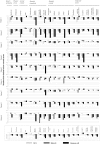Connected speech as a marker of disease progression in autopsy-proven Alzheimer's disease
- PMID: 24142144
- PMCID: PMC3859216
- DOI: 10.1093/brain/awt269
Connected speech as a marker of disease progression in autopsy-proven Alzheimer's disease
Abstract
Although an insidious history of episodic memory difficulty is a typical presenting symptom of Alzheimer's disease, detailed neuropsychological profiling frequently demonstrates deficits in other cognitive domains, including language. Previous studies from our group have shown that language changes may be reflected in connected speech production in the earliest stages of typical Alzheimer's disease. The aim of the present study was to identify features of connected speech that could be used to examine longitudinal profiles of impairment in Alzheimer's disease. Samples of connected speech were obtained from 15 former participants in a longitudinal cohort study of ageing and dementia, in whom Alzheimer's disease was diagnosed during life and confirmed at post-mortem. All patients met clinical and neuropsychological criteria for mild cognitive impairment between 6 and 18 months before converting to a status of probable Alzheimer's disease. In a subset of these patients neuropsychological data were available, both at the point of conversion to Alzheimer's disease, and after disease severity had progressed from the mild to moderate stage. Connected speech samples from these patients were examined at later disease stages. Spoken language samples were obtained using the Cookie Theft picture description task. Samples were analysed using measures of syntactic complexity, lexical content, speech production, fluency and semantic content. Individual case analysis revealed that subtle changes in language were evident during the prodromal stages of Alzheimer's disease, with two-thirds of patients with mild cognitive impairment showing significant but heterogeneous changes in connected speech. However, impairments at the mild cognitive impairment stage did not necessarily entail deficits at mild or moderate stages of disease, suggesting non-language influences on some aspects of performance. Subsequent examination of these measures revealed significant linear trends over the three stages of disease in syntactic complexity, semantic and lexical content. The findings suggest, first, that there is a progressive disruption in language integrity, detectable from the prodromal stage in a subset of patients with Alzheimer's disease, and secondly that measures of semantic and lexical content and syntactic complexity best capture the global progression of linguistic impairment through the successive clinical stages of disease. The identification of disease-specific language impairment in prodromal Alzheimer's disease could enhance clinicians' ability to distinguish probable Alzheimer's disease from changes attributable to ageing, while longitudinal assessment could provide a simple approach to disease monitoring in therapeutic trials.
Keywords: Alzheimer’s disease; aphasia; connected speech analysis; language; neuropsychological tests.
Figures




References
-
- Ahmed S, de Jager CA, Haigh AM, Garrard P. Logopenic aphasia in Alzheimer's disease: clinical variant or clinical feature? J Neurol Neurosurg Psychiatry. 2012;83:1056–62. - PubMed
-
- Ahmed S, de Jager CA, Haigh AM, Garrard P. Semantic processing in connected speech at a uniformly early stage of autopsy-confirmed Alzheimer's disease. Neuropsychology. 2013;27:79–85. - PubMed
-
- Almor A, Kempler D, MacDonald MC, Andersen ES, Tyler LK. Why do Alzheimer patients have difficulty with pronouns? Working memory, semantics, and reference in comprehension and production in Alzheimer's disease. Brain Lang. 1999;67:202–27. - PubMed
-
- Berndt RS, Wayland S, Rochon E, Saffran EM, Schwartz MF. Hove, UK: Psychology Press; 2000. Quantitative production analysis; a training manual for the analysis of aphasic sentence production. - PubMed
Publication types
MeSH terms
Grants and funding
LinkOut - more resources
Full Text Sources
Other Literature Sources
Medical
Miscellaneous

